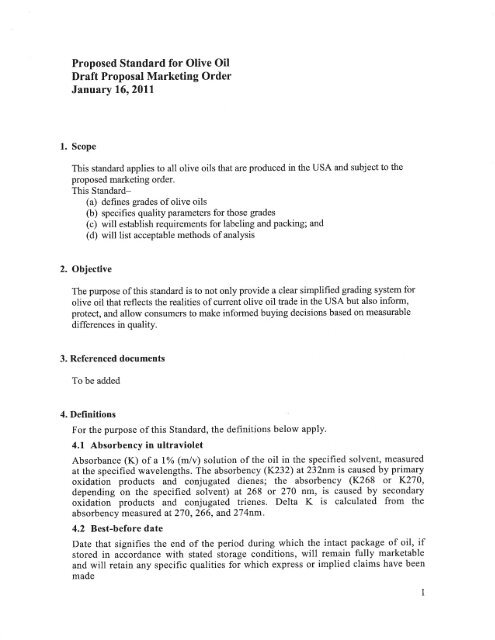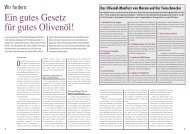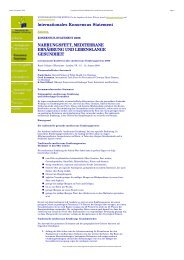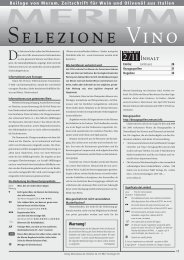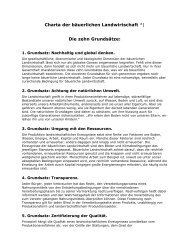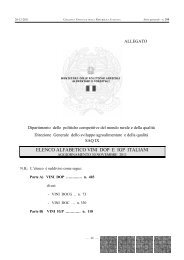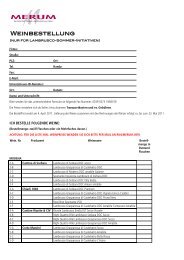Proposed Standard for Olive Oil Draft Proposal Marketing ... - Merum
Proposed Standard for Olive Oil Draft Proposal Marketing ... - Merum
Proposed Standard for Olive Oil Draft Proposal Marketing ... - Merum
You also want an ePaper? Increase the reach of your titles
YUMPU automatically turns print PDFs into web optimized ePapers that Google loves.
<strong>Proposed</strong> <strong>Standard</strong> <strong>for</strong> <strong>Olive</strong> <strong>Oil</strong><br />
<strong>Draft</strong> <strong>Proposal</strong> <strong>Marketing</strong> Order<br />
January 16, 2011<br />
1. Scope<br />
This standard applies to all olive oils that are produced in the USA and subject to the<br />
proposed marketing order.<br />
This <strong>Standard</strong>—<br />
(a) defines grades of olive oils<br />
(b) specifies quality parameters <strong>for</strong> those grades<br />
(c) will establish requirements <strong>for</strong> labeling and packing; and<br />
(d) will list acceptable methods of analysis<br />
2. Objective<br />
The purpose of this standard is to not only provide a clear simplified grading system <strong>for</strong><br />
olive oil that reflects the realities of current olive oil trade in the USA but also in<strong>for</strong>m,<br />
protect, and allow consumers to make in<strong>for</strong>med buying decisions based on measurable<br />
differences in quality.<br />
3. Referenced documents<br />
To be added<br />
4. Definitions<br />
For the purpose of this <strong>Standard</strong>, the definitions below apply.<br />
4.1 Absorbency in ultraviolet<br />
Absorbance (K) of a 1% (m/v) solution of the oil in the specified solvent, measured<br />
at the specified wavelengths. The absorbency (K232) at 232nm is caused by primary<br />
oxidation products and conjugated dienes; the absorbency (K268 or K270,<br />
depending on the specified solvent) at 268 or 270 nm, is caused by secondary<br />
oxidation products and conjugated trienes. Delta K is calculated from the<br />
absorbency measured at 270, 266, and 274nm.<br />
4.2 Best-be<strong>for</strong>e date<br />
Date that signifies the end of the period during which the intact package of oil, if<br />
stored in accordance with stated storage conditions, will remain fully marketable<br />
and will retain any specific qualities <strong>for</strong> which express or implied claims have been<br />
made<br />
1
4.3 Diacylglycerol (DAG)<br />
A diacylglycerol (DAG) is an acylglycerol consisting of two fatty acid chains<br />
covalently bonded to a glycerol molecule through ester linkages. In virgin olive oils,<br />
DAGs are present in a range of 1 to 3% and they are found as 1,2- and 1,3- isomers.<br />
Fresh extra virgin olive oil contains a high proportion of 1,2-isomers to 1,2- and<br />
1,3-isomers.<br />
4.4 Flavor<br />
The sensory impression of oil, determined mainly by the senses of taste and smell.<br />
Refers to the typical flavor of olive oil produced from olives and the degree of<br />
positive or negative attributes.<br />
4.5 Free fatty acid content/free acidity<br />
Free fatty acids are <strong>for</strong>med by the hydrolysis of the triacylglycerols in oils. The<br />
content of free fatty acids in grams per 100 grams expressed as percent of free oleic<br />
acid.<br />
4.6 Median of defects<br />
4.6.1 General<br />
A calculation of the median score of a panel of tasters who characterize the olive<br />
oil's negative flavor and odor attributes. Negative attributes are any flavor or<br />
odor that derives from enzymatic degradation, fermentation, or microbial<br />
spoilage of olives prior to processing, fermentation of olive matter following<br />
extraction, subsequent excessive oxidation, or any other character that could not<br />
be reasonably assigned to the natural flavors derived from the olive. These<br />
include, but are not limited to the defects known as fusty, muddy-sediment,<br />
musty, rancid and winey-vinegary.<br />
4.6.2 Median of defects—Fusty<br />
A flavor defect attributable to poor storage conditions of the olives, usually<br />
promoting the bacterial growth of the Clostridium and Pseudomonas genera.<br />
4.6.3 Median of defects—Muddy sediment<br />
A flavor defect caused by storage in contact with oil sediment <strong>for</strong> long periods<br />
4.6.4 Median of defects—Musty<br />
A flavor defect occurring when low temperatures and high humidity promote<br />
mould growth, mainly of the Aspergillus and Pen icilium genera.<br />
4.6.5 Median of defects—Rancid<br />
A flavor defect caused by the oxidation of the oil and subsequent <strong>for</strong>mation of<br />
aldehydes during the production process giving the oil an oxidized flavor and<br />
odor.<br />
4.6.6 Median of defects—Winey-vinegary<br />
A flavor defect caused by storage condition of the olives that causes aerobic<br />
fermentation by the growth of yeasts that produce ethanol, acetic acid, and ethyl<br />
acetate.<br />
2
4.7 Median of fruity<br />
A calculation of the median score from a panel of tasters who assess the intensity of<br />
the positive fruity characteristics of the olive oils.<br />
4.8 Odor or aroma<br />
An odor or aroma is a volatilized chemical compound, generally at a very low<br />
concentration, that is perceived by olfaction.<br />
4.9 Operator<br />
Person or company that runs or is involved in one or more parts of the olive oil<br />
trading business.<br />
4.10 Organoleptic analysis<br />
Evaluation based on flavor and odor characteristics.<br />
4.11 Pyropheophytin a<br />
Degradation product of chlorophyll a that results from thermal or age related<br />
degradation of the product.<br />
4.12 Oxidative stability index<br />
An indicator of the stability and the shelf life properties of oils. The determination<br />
entails speeding up the oxidation process in the oil under heat and air current and<br />
monitoring volatile substances associated with rancidity.<br />
4.13 Trans fatty acid<br />
All the geometrical isomers of monounsaturated and polyunsaturated fatty acids<br />
having one or more non-conjugated carbon-carbon double bond in the trans<br />
configuration interrupted by at least one methylene group.<br />
5. Product description<br />
<strong>Olive</strong> oil is the oil obtained from the fruit of the olive tree (Oka europaea L), excluding<br />
oils obtained using re-esterification processes and any mixture with other kinds of oils.<br />
6. Grades of olive oil<br />
(a) Extra virgin olive oil<br />
(b) <strong>Olive</strong> oil<br />
(c) <strong>Olive</strong> oil not fit <strong>for</strong> human consumption without further processing<br />
3
7. Quality Parameters For grades of olive oil (Table 1)<br />
Quality Parameter<br />
Free fatty acid (FFA)<br />
(% as oleic acid)<br />
Absorbency<br />
in ultraviolet<br />
K232 (K<br />
%<br />
K270 l e m ) (K<br />
%<br />
I De<br />
c(Km )<br />
o<br />
Moisture and volatile lta / matter<br />
(MOI) (% m/m) KG<br />
Insoluble impurities I (INI)<br />
(% m/m) c<br />
Pyropheophytin ma<br />
(PPP)<br />
(Area %) )<br />
1,2-Diacylglycerols (DAGs)<br />
(Area %)<br />
Median of<br />
defects<br />
Organoleptic (MeD)<br />
analysis Median of<br />
fruitiness<br />
(MeF)<br />
8. Food additives<br />
8.1 Extra virgin olive oil<br />
Extra<br />
virgin<br />
olive oil<br />
<strong>Olive</strong> oil<br />
<strong>Olive</strong> oil not fit<br />
<strong>for</strong><br />
consumption<br />
without further<br />
processing<br />
2.0<br />
_2.30 2.60 >2.60<br />
_0.20 0.25 >0.25<br />
./0.01/ /0.01/ >10.01/<br />
D34.2 __0.2 0.3<br />
0.0 N/A N/A<br />
Extra virgin olive oils shall not contain food additives.<br />
8.2 <strong>Olive</strong> oil<br />
Tocopherols may be added to olive oil, to restore natural tocopherols lost in the<br />
refining process up to a maximum level of 200 mg/kg of total alpha-tocopherol in<br />
the final product.<br />
8.3 Processing aids<br />
Processing aids are allowed during the oil extraction process to the extent allowed<br />
by the<br />
4
9. Contaminants<br />
9.1 Heavy metals<br />
The products covered by this <strong>Standard</strong> shall comply with maximum limits<br />
established by the<br />
9.2 Copper and Iron<br />
Specific limits <strong>for</strong> copper (Cu) and iron (Fe) in extra virgin olive oils and olive oil<br />
are Cu (1.1 mg/kg and Fe 3.1:) mg/kg.<br />
9.3 Pesticide residues<br />
The products covered by this <strong>Standard</strong> shall comply with the maximum pesticide<br />
residue limits established by the<br />
9.4 Polycyclic aromatic hydrocarbons (PAHs)<br />
With regard to polycyclic aromatic hydrocarbons (PAHs), also known as polyaromatic<br />
hydrocarbons, the products covered by this <strong>Standard</strong> shall comply with<br />
maximum limits established by the<br />
10. Hygiene<br />
Products covered by this <strong>Standard</strong> that are intended <strong>for</strong> human consumption shall be<br />
prepared and handled in accordance with I t is recommended that<br />
products covered by the provisions of this <strong>Standard</strong> are prepared and handled in<br />
accordance with the Codex Recommended International Code of Practice—General<br />
Principles of Food Hygiene (CAC/RP 1), and its Annex on Hazard Analysis and<br />
Critical Control Point (HACCP) System and Guidelines <strong>for</strong> its Application.<br />
11. Packaging<br />
11.1 General<br />
Extra virgin olive oils and olive oils intended <strong>for</strong> trade shall be packed in containers<br />
complying with the General Principles of Food Hygiene recommended by the<br />
Codex Alimentarius Commission (CAC/RCP 1), and other relevant texts such as<br />
codes of hygienic practice and codes of practice.<br />
When packaging edible extra virgin olive oils and olive oils operators shall—<br />
(a) only use packaging material that is fit <strong>for</strong> its intended use in order to minimize<br />
deterioration of quality and to ensure that the product grade and associated<br />
characteristics continue to meet the requirements of this <strong>Standard</strong> <strong>for</strong> the<br />
duration of the product's stated shelf life;<br />
(b) only use material that is not likely to cause oil contamination;<br />
(c) ensure that there is no likelihood that the oils may become contaminated<br />
during the packaging process.<br />
5
11.2 Labeling<br />
11.2.1 General<br />
Operators are advised that labelling requirements, in addition to those set out<br />
in this <strong>Standard</strong>, may be specified in laws, regulations and standards.<br />
In addition to sections ?, 1, 7 and R of the codex General <strong>Standard</strong> <strong>for</strong> the<br />
Labelling of Pre-packaged Foods (Codex STAN 1) and the standards<br />
applying to food intended <strong>for</strong> direct sale to consumers in<br />
the<br />
11.2.2 Name of the product<br />
11.2.2.1 General<br />
The labelling on each container shall indicate the grade (of the product<br />
as specified and determined by this <strong>Standard</strong>. Operators shall ensure<br />
that the designation and an additional description of the product<br />
complies with the<br />
Indications shown on the labelling shall not mislead the purchaser,<br />
particularly as to the characteristics of the oil concerned, or by<br />
attributing to it properties which it does not possess, or by suggesting<br />
that it possesses special characteristics where those characteristics are<br />
common to most oils.<br />
11.2.2.2 Grades of olive oils<br />
The following are the permitted designations <strong>for</strong> labelling:<br />
(a) Extra virgin olive oil<br />
(b) <strong>Olive</strong> oil<br />
(c) <strong>Olive</strong> <strong>Oil</strong> not fit <strong>for</strong> human consumption without further processing<br />
The designations shall be prominent and clearly legible in full in the<br />
principal display panel of the label.<br />
Any other designations (e.g. Pure <strong>Olive</strong> <strong>Oil</strong>, Light or Lite <strong>Olive</strong> <strong>Oil</strong>,<br />
Extra Light or Lite <strong>Olive</strong> <strong>Oil</strong>) shall not be used.<br />
No adjective of any kind (e.g. Premium, Super, Light, Lite, Pure) shall<br />
be used together with the approved designation of oils by presenting<br />
them on the same line as, or having equal or greater prominence than,<br />
the designation.<br />
Words describing country or region of origin (e.g. Cali<strong>for</strong>nia, Tuscan,<br />
Spanish, etc.); oil character (e.g. mellow, fruity, robust, etc.); and/or<br />
processing method (e.g. cold pressed, first extraction, etc.) shall only be<br />
used where the in<strong>for</strong>mation can be substantiated and does not mislead<br />
consumers.<br />
11.2.2 Name and address<br />
The name and address of the manufacturer, packer, distributor, importer,<br />
exporter or seller shall be declared in accordance with the<br />
6
11.2.3 Country of origin<br />
The use of the country or countries of origin on the label shall comply<br />
with<br />
11.2.4 Lot identification<br />
Each container shall be embossed or otherwise permanently marked in code<br />
or in clear writing to identify the producing factory and the lot in accordance<br />
with the<br />
11.2.5 Best-be<strong>for</strong>e date<br />
11.2.5.1 General<br />
The best-be<strong>for</strong>e date shall be declared on the principal label of the<br />
product in accordance with the<br />
Extra virgin olive oils and olive oils shall not display a best-be<strong>for</strong>e date<br />
greater than two years from the date of packaging. Harvest date may<br />
also be included on the principal label.<br />
11.2.5.2 Determination of best-be<strong>for</strong>e date<br />
The best-be<strong>for</strong>e date shall be supported by technical evidence. Methods<br />
used to determine oil durability may include:<br />
(a) <strong>Oil</strong> oxidative stability index in accordance with Clause 12.11.<br />
(b) Fatty acid profile and antioxidant content.<br />
11.2.6 Optional indications<br />
11.2.6.1 General<br />
Optional indications listed in Clauses 11.2.6.2, 11.2.6.3 and 12.2.6.4<br />
may appear on the label of olive oils.<br />
11.2.6.2 Organic<br />
The words 'organic' shall only be used to describe the oil where the oil<br />
complies with the requirements of<br />
11.2.6.3 First cold pressing<br />
The indication 'first cold pressing', 'cold pressing', or similar, may<br />
appear only <strong>for</strong> extra virgin olive oils obtained from a first mechanical<br />
pressing of the olive paste by using a mechanical, hydraulic or<br />
centrifugal press at a temperature that does not lead to significant<br />
thermal alterations.<br />
11.2.6.4 Cold extraction<br />
The indication 'cold extraction' or 'cold crushed', or similar, may<br />
appear only <strong>for</strong> extra virgin olive oils obtained by any mechanical or<br />
other physical means at a temperature that does not lead to significant<br />
thermal alterations.<br />
7
12. Methods of analysis<br />
12.1 General<br />
11.2.6.5 Storage instructions<br />
The label shall include specific storage conditions (e.g. dark conditions<br />
and cool temperatures) necessary to ensure the validity of the bestbe<strong>for</strong>e<br />
date declared on the label. The statement of those conditions<br />
shall be of equal or greater prominence as the best-be<strong>for</strong>e date.<br />
The methods set out in this Clause (8), or alternative methods providing equivalent<br />
results, shall be used to determine the characteristics extra virgin olive oils, olive<br />
oils or olive oils not fit <strong>for</strong> consumption without further processing. At all times, the<br />
most recently published version of the stated methods shall be used.<br />
12.2 Preparation of the test sample<br />
Test samples shall be prepared in accordance with ISO 661, Animal and vegetable<br />
fats and oils.<br />
12.3 Determination of the trans fatty acid content<br />
Trans fatty acid content shall be determined in accordance with ISO 15304 or<br />
AOCS Ch 2a-94 (Rev. 2002) or IOC/T.20/Doc. 17.Rev.l.<br />
12.4 Determination of organoleptic characteristics<br />
Organoleptic characteristics shall be determined in accordance with<br />
C0I/T.20/Doc. 15. Rev.2. or AOCS<br />
12.5 Determination of free fatty acid content<br />
Free fatty acid content shall be determined in accordance with ISO 660 or<br />
AOCS Ca 5a-40.<br />
12.6 Determination of absorbency in ultraviolet<br />
Absorbency in ultraviolet shall be determined in accordance with ISO 3656 or<br />
AOCS Ch 5-91 or IOC/T.20/Doc.19. Rev.2.<br />
12.7 Determination of moisture and volatile matter<br />
Moisture and volatile matter shall be determined in accordance with ISO 662 or<br />
AOCS Ca 2c-25.<br />
12.8 Determination of insoluble impurities in light petroleum<br />
Insoluble impurities in light petroleum shall be determined in accordance with<br />
ISO 663, or AOCS Ca 3a-46.<br />
12.9 Determination of trace metals<br />
Determination of copper and iron by direct graphite furnace atomic absorption<br />
spectrometry shall be in accordance with ISO 8294.<br />
8
12.10 Determination of traces of heavy metals<br />
12.10.1 Determination of traces of heavy metals—Lead<br />
Traces of lead shall be determined in accordance with ISO 12193 or<br />
AOCS Ca 18c-91 or AOAC 994.02.<br />
12.10.2 Determination of traces of heavy metals—Arsenic<br />
Traces of arsenic shall be determined in accordance with AOAC 952.13 or<br />
AOAC 942.17 or AOAC 985.16.<br />
12.11 Determination of oxidative stability index<br />
Oxidative stability index shall be determined in accordance with AOCS Cd 12b-92.<br />
12.12 Determination of pyropheophytins<br />
The degradation products of chlorophylls a and a' (pheophytins a, a' and<br />
pyropheophytins) shall be determined in accordance with ISO 29841.<br />
12.13 Determination of 1,2-Diacylglycerol content<br />
Relative amounts of 1,2- and 1,3-diacylglycerols shall be determined in accordance<br />
with ISO 29822.<br />
9


